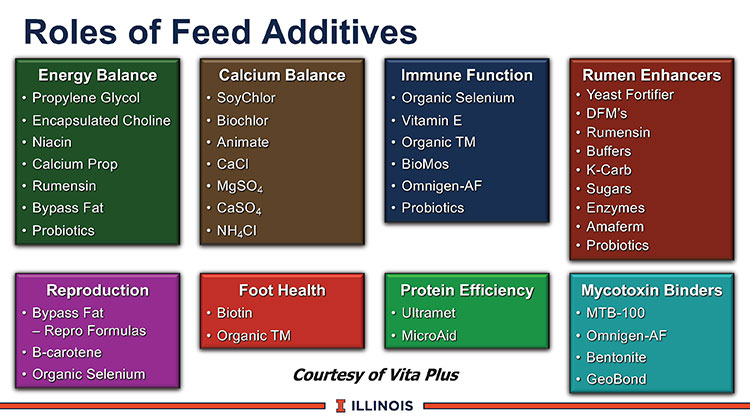
“If you can feed B vitamins at an economical price, do it!” encouraged Mike Hutjens. That was one of the messages viewers received as the University of Illinois nutrition icon presented “An update on feed additives with a B vitamin focus” during the April Hoard’s Dairyman webinar.
Feed additives find their way into a ration more easily when feed costs are low and milk prices are high. However, tight margins are the norm, and these additives need to be evaluated for their ability to help cows produce more milk, improve foot health, or stimulate immunity. From a strictly cost side, when profits are down, additives are often the first pulled. But, before you take that step, consider the benefit:cost ratio and determine if removing them from the ration could be more expensive in the long run.
There are a variety of additives, and the chart below details their role in dairy cattle nutrition. Hutjens drew extra attention to the immune function additives, calling them “the new kid on the block,” as they will play a greater role in diet formulation moving forward.

Hutjens provided a list of the items he would include in rations (see below). The items in blue are recent changes to his recommendations, based on new research. Hutjens emphasized that the farm owner or nutritionist must make the final decision on what works best in each herd.
Additives recommended for lactating cow
- Rumen buffers
- Yeast culture/yeast products
- Monensin (Rumensin)
- Silage inoculants
- Biotin
- Organic trace minerals
- Mycotoxin binder – maybe
Additives recommended for close-up dry cows
- Yeast culture/yeast products
- Monensin (Rumensin)
- Silage inoculants
- Organic trace minerals + chromium
- Rumen protected choline
- Anionic product
Additives recommended for fresh cows
- Rumen buffers
- Yeast culture/yeast products
- Monensin (Rumensin)
- Calcium supplement (bolus/drench)
- Silage inoculants
- Biotin
- Organic trace minerals + chromium
- Rumen protected choline
B vitamins function through enzymes and are key in metabolism, as cows use them for glucose synthesis, fertility, and immunity. The issue is that B vitamins are significantly degraded in the rumen. For this reason, some B vitamins are fed in protected (encapsulated or embedded) forms, allowing them to avoid the rumen’s harsh environment.
The most commonly fed B vitamins are biotin, niacin, and rumen-protected choline. Biotin is fed to improve foot health and positive milk gains have been seen. He cautioned listeners to be patient and wait six to 12 months before determining the success of biotin in the ration. Feeding more than the recommended amount is not only expensive, but it resulted in lower dry matter intake (DMI) and a drop in milk production. If given a choice, Hutjens would choose the protected option.
Feed: 20 mg/cow/day in nonprotected form or 10 mg/cow/day in protected form
Niacin can be fed in nonprotected and protected forms. Nonprotected niacin fed at 12 grams per day is ideal, as feeding half that amount is ineffective. When fed at the recommended amount, milk production rose, as well as fat, protein, and feed efficiency. Hutjens recommends protected niacin for transition cows. Results included higher dry matter intake and lower ketosis incidences. However, there was no change in milk production. Niacin in encapsulated form has also shown to reduce heat stress.
Feed: 12 g/cow/day in nonprotected form or 3 g in protected form
Rumen protected choline (RPC) increases milk production (due to elevated DMI), and research shows that boost is highly significant even though it comes at a higher cost of about 30 cents per cow per day. But the long-term effects are noteworthy. Cows fed RPC during the transition period were on a higher trajectory over the entire lactation for milk production and maintained it. Those cows also had improved colostrum Brix refractometer scores, and their calves had more effective IgG absorption. To top it off, the developing fetus would go on to produce more milk when it became a lactating cow two years later.
Feed: 15 g/cow/day
There are additives which contain different combinations of B vitamins, called rumen-protected blends. Their exact composition varies depending on the manufacturer. Hutjens urged attendees to evaluate the B vitamin profile before selecting a blend.
Mike Hutjens gave the audience a lot to think over. Detailed slides and charts are found in the archived presentation. This webinar was sponsored by Provimi.
Join us next month:

University of Wisconsin-Madison's Paul Fricke will present “The implications of high pregnancy rates on reproductive strategies” on Monday, May 11 at noon (Central time).
Fricke will delve into dairy cattle reproduction research and address limitations to fertility. He also will discuss strategies for utilizing sexed semen, beef sires, in vitro fertilization, and embryo transfer. This webinar is sponsored by Neogen. Register here.

The author is the online media manager and is responsible for the website, webinars, and social media. A graduate of Modesto Junior College and Fresno State, she was raised on a California dairy and frequently blogs on youth programs and consumer issues.








